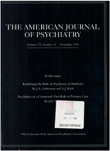Clinical characteristics of patients with concurrent major depressive disorder and panic disorder
Abstract
OBJECTIVE: This study was designed to test the hypothesis that patients with both major depressive disorder and panic disorder exhibit more clinical symptoms and have a more protracted course of illness than patients with major depressive disorder only. METHOD: The authors compared standardized clinical evaluations (from Schedule for Affective Disorders and Schizophrenia interviews) of 119 patients with major depressive disorder only and 57 patients with major depressive disorder and concurrent panic disorder. Clinical and demographic variables were included. RESULTS: The patients with both disorders reported symptoms of major depressive disorder earlier in life and also required treatment and hospital admission earlier in life. Many clinical features during the index episode were significantly more severe in the patients with both disorders. A logistic regression identified a "panic index" consisting of the symptoms of somatic anxiety, phobia, indecisiveness, and feelings of inadequacy. Scores on this index allowed proper classification of patients to either of the two diagnostic groups with high reliability. CONCLUSIONS: In major depressive disorder, the presence of panic disorder is suggestive of a more severe and precocious form of illness.
Access content
To read the fulltext, please use one of the options below to sign in or purchase access.- Personal login
- Institutional Login
- Sign in via OpenAthens
- Register for access
-
Please login/register if you wish to pair your device and check access availability.
Not a subscriber?
PsychiatryOnline subscription options offer access to the DSM-5 library, books, journals, CME, and patient resources. This all-in-one virtual library provides psychiatrists and mental health professionals with key resources for diagnosis, treatment, research, and professional development.
Need more help? PsychiatryOnline Customer Service may be reached by emailing [email protected] or by calling 800-368-5777 (in the U.S.) or 703-907-7322 (outside the U.S.).



